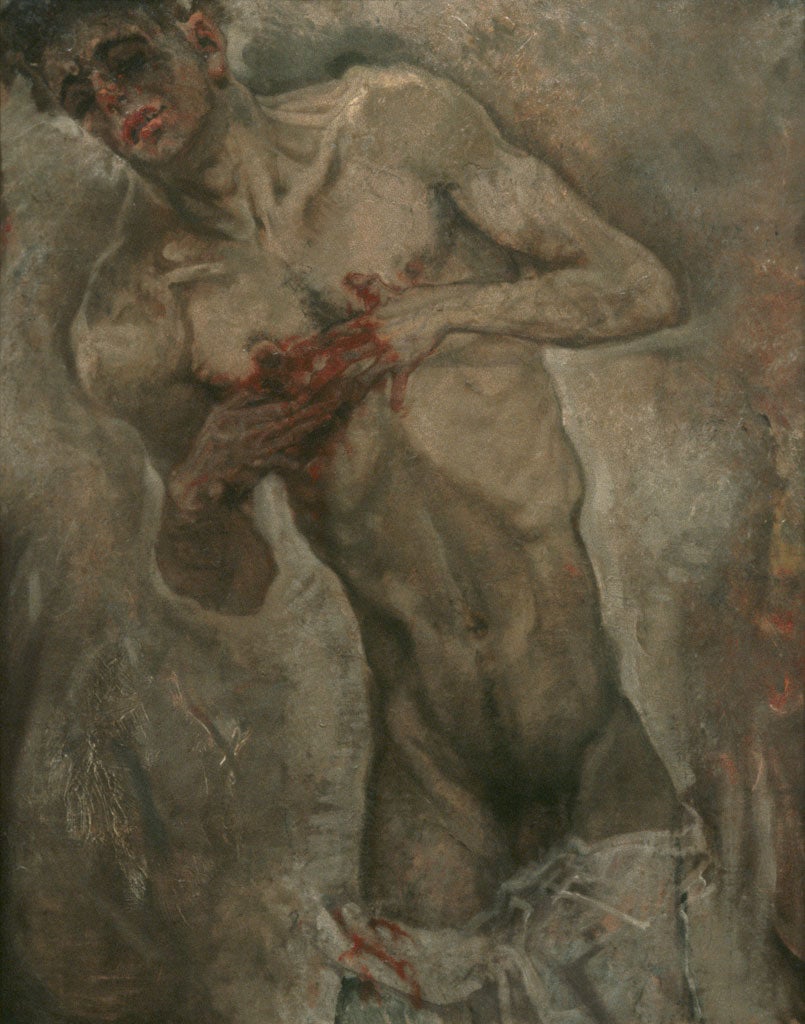Great Works: Der Blutende (The Bleeding Man), 1911 (103.9 x 80.5 cm), Max Oppenheimer
Spencer Museum of Art, Kansas

Your support helps us to tell the story
From reproductive rights to climate change to Big Tech, The Independent is on the ground when the story is developing. Whether it's investigating the financials of Elon Musk's pro-Trump PAC or producing our latest documentary, 'The A Word', which shines a light on the American women fighting for reproductive rights, we know how important it is to parse out the facts from the messaging.
At such a critical moment in US history, we need reporters on the ground. Your donation allows us to keep sending journalists to speak to both sides of the story.
The Independent is trusted by Americans across the entire political spectrum. And unlike many other quality news outlets, we choose not to lock Americans out of our reporting and analysis with paywalls. We believe quality journalism should be available to everyone, paid for by those who can afford it.
Your support makes all the difference.Blood is never only blood – and especially at this moment in the Christian year. It sustains us all. It is also a magical substance. The Christian myth tells us that Christ shed his blood for all our sakes, in order to redeem the fallen; and the drinking of that blood, miraculously made available to us over and over again as if from some inexhaustible well, is central to the Catholic Mass.
This young man seems to be embodying some ill-defined blood myth, part Christian, part not. It is all so ravishingly ambiguous. The atmosphere feels somewhat sacred, and yet the body itself could be engaged in an entirely secular act of self-exposure, with that delicate revelation of the genitals as the white, diaphanous flurry slips away. The figure could be either standing or lying. The pose of the figure is curious, that strange lean to the right, which extends his body, stretching it like a tube; the face is trance-like, a tad saintly. The body seems a little too fully rounded to be lying – surely it would look more settled into itself if that were indeed the case. The man is caught up, utterly self-absorbed – or he is being drawn up physically in some way that may suggest the Assumption. There seems to be a powerful emotional connection between the drama of the bloodied fingers as they knit, pull away from each other or dabble in the wound that they are tamping so gingerly, and the expression on the face, those full, parted lips, the closed eyes. What the fingers are doing – they are presented to us so centrally – is helping to dictate the mood of the painting. Their positioning over the wound helps to give it some additional symbolic force, which may hark back to Christ's wounding with a spear. Doubting Thomas needed to put his hand into Christ's wound in order to believe. Perhaps this dabbling with the wound is causing a narrative of heroic sacrifice to unfold within the enraptured mind of this young man. Or not.
Another possibility is that the body is lying, and that its curve is due to the fact that this is a man on a bed of some kind, the body outspread against cloth – the background is rendered so indefinably scrubbily that we can never be really sure. This would, all the same, be a good explanation for this posture, and for the way that the head lolls helplessly. In which case, the man could be sleeping, head supported, nursing his wound.
He is both a bloodied sacrificial victim and some kind of a homo-erotic offering to the viewer – as so many depictions of Christ were too. He rises up in all the magnificence of his exposed youthfulness,a or he lies there like a toppling, stricken column in all the terrible mess of his injuries.
ABOUT THE ARTIST
The work of the chameleonic Viennese painter Max Oppenheimer (1885-1954) moved through a variety of styles and influences that span the 19th and 20th centuries. His earliest paintings show evidence of Impressionism; later, having worked alongside Kokoschka, Schiele and others, he shifted towards Dadaism, participating in the first Dada exhibition in Zurich in 1916. His later works often show Cubist traits. Towards the end of his life, having been denounced as degenerate by the Nazis, he moved to New York, and, just before he died, he began to absorb the lessons of Abstract Impressionism. A true Zelig.
Join our commenting forum
Join thought-provoking conversations, follow other Independent readers and see their replies
Comments